
JASON AND THE ARGONAUTS
A MOURNINGSIDE PRODUCTION
Distributed by COLUMBIA PICTURES CORPORATION
UK (1963): Fantasy/Adventure
104 min, No rating, Color
 |
JASON AND THE ARGONAUTS
A MOURNINGSIDE PRODUCTION
|
A 30 second TV promo spot for CLASH OF THE TITANS precedes JASON AND THE ARGONAUTS.
Written by: Beverly Cross, Jan Read; Cinematography by: Wilkie Cooper; Music by: Bernard Herrmann; Production Design by: Geoffrey Drake; Film Editing by: Maurice Rootes; Produced by: Charles H. Schneer, Ray Harryhausen (associate); Assistant director: Dennis Bertera; Art director: Tony Sarzi Braga; Sound: Cyril Collick; Sound editor: Alfred Cox; Continuity: Phyllis Crocker; Production Manager: John Dark; Camera Operator: Harry Gillam; Special Visual Effects: Ray Harryhausen; Model sculpture: Arthur Hayward; Unit manager: Jimmy Komisarjevsky; Swordfight arranger: Fernando Poggi; Title design: James Wines
Behind The
Scenes
Ray found that the sodium process would be unavailable for the entire length of the shooting schedule so he decided to use the blue screen process at Shepperton Studio. Full size sections of the Argos were constructed as well as miniature ones in a two foot and two inch variation. For the section that has the Argos going between the clashing rocks, studio craftsman devised a clever looking set that originally proved to be disastrous. The entire sequence was filmed at 96 and 110 frames per second to give the illusion of weight and as the heavy rocks, made out of plaster covered styrofoam, tumbled to the water, they would collide with a splash and then FLOAT! Alterations were made on the rocks and the sequence proves to be very exciting.
The first stop-motion creature to appear on the screen in TALOS, a giant bronze statue. While large section of TALOS were created, like his foot and hand, Talos was an 18 inch rubber creature designed over an armature and painted bronze. Ray has spent his life attempting to make his animation look as smooth as possible. For Talos, Ray had to create the illusion of a giant mechanical man so he had to abandon the smooth look and create a less fluid and more jerky appearance to the animation. The combination of deliberate jerky stop-motion movement and the creaking sounds heard on the films soundtracks add to the illusion that this giant statue has actually come to life. The life-size hand/arm were used as Talos first encounters the Argonauts on the beach. The foot section was constructed for the segment in which Jason finds Talos' Achilles heel-so to speak.
For the sequence in which the hot steam empties from Talos heel, Ray simply constructed a cellophane wheel and filmed it, later having it optically inserted into the sequence. As Talos life is draining from him he begins to crumbles and falls, resulting in Harryhausen having to tediously animate each of the breaking pieces so that it moved in conjunction with the toppling Talos. The attention to detail pays off in this sequence, regarded by many as one of Ray's finest stop-motion segments.
The next stop-motion sequence involves The Harpies. In 1954 Ray became obsessed with flying demons and developed a script for a failed project called THE ELEMENTALS. Test footage was shot to show the possibility of the subject that included Ray himself, fighting off one of these winged demons. This test footage is included on the special laserdisc edition of JASON AND THE ARGONAUTS and is worth the price of the disc alone, that and the fact that Ray provides a very informative and entertaining commentary on the analog tracks of the movie. Critics often draw attention to the unrealistic movements of the Harpies wings during this sequence, but I have always found the startling movement to add to the fantasy element of the film. I find it amazing that critics will draw attention that the strobe effect makes these creatures not look real when the creatures themselves aren't real. The strobbed fluttering of the wings gives them an otherworldly and very eerie quality. The sequence was originally designed to be shot as a day for night sequence but when the film reached the screen it was a fully lit sequence. Ray has corrected this problem with the recent remastering of the film. Setting the capture of the Harpies at early dusk makes the sequence so much more exciting. The Harpies cast shadows on the set and for one sequence a wire was connected to Patrick Troughton's belt so that it could appear to be pulled off by the harpies making the interaction between live action and stop-motion more plausible.
The seven-headed hydra would be Ray's next creation to appear in the film. This proved to be a particularly difficult sequence since each of the seven heads had to be animated. Quite often, because of the precision of Ray's work he could only average 13 to 14 frames of animation a day. If he was interrupted at his work he had to remember which heads were moving forward and which were moving backward. It also required the inclusion of two animated human characters from the film. As the sequence begins the Hydra appears coming out of a cave in an attempt to stop Jason from stealing the Golden Fleece. When it fully emerges we discover that he has a stop-motion Acastus in his tail. Acastus is dropped, since he is nearly dead and Jason is attacked. During the fight, Jason is picked up by the creature in a sequence that required a stop-motion Jason for some scenes and a live size mock-up of the Hydra's tail for others. Todd Armstrong was picked up by the creature's tail and through careful editing the sequence flows with beautiful precision. The final scene with the Hydra has Jason thrusting his sword into the Hydra. This required a sequence in which a live action Jason, holding a sword would stab the stop-motion creature. This was accomplished by having Todd Armstrong literally thrusting the sword forward and letting it go while filming the live action back-plate. The stop motion creature was animated to match the live-action sequence so that the moment Armstrong would let go of the sword a miniature sword was placed in the Hydra's chest creating the illusion that Armstrong had actually killed the beast.
The Hydra sequence leads almost directly into the final stop-motion sequence, Jason's encounter with the seven skeletons. The live action was shot first, requiring seven swordsmen to stand in for the skeletons during rehearsals. Each swordsman had a number on his back so his motions could be tracked and perfectly choreographed. When the actors in the sequence had the steps of the fight sequence down, the sequence was shot without the swordsmen. Anyone stumbling on the shooting set that day would have thought all of this looked quite ridiculous. Here were these actors fighting thin air, as though they had an invisible enemy. Ray then used this footage to animated the skeletons creating a stunning sequence in which the actors appear to actually be battling these hideous and evil looking skeletons. In the original story of Jason, rotted corpses of the dead victims of the hydra were resurrected but Ray decided that the sequence would be to gruesome that way and went for the skeletons-outdoing the similar sequence from 7TH VOYAGE OF SINBAD. Though this entire sequence only plays for a few moments on the screen it took Ray four and a half months to animate it.
Ray is sometimes criticized for not making one of the live-action creatures of the film a stop-motion one. During the clashing rocks sequence, a giant sea-god emerges from the water to hold the rocks back from destroying the Argos. The film is shot with a live actor. The fact that all of the other gods in the film are actors might be a clear enough reason to use an actor for this sequence rather than a stop-motion creature. As the sequence appears on the screen the suspension is disbelief is accomplished quite effectively. I don't think the same would have been true with stop-motion creature. Animating this sequence would have required a great deal of time and the animated creature would have had to have been huge to get the same effect as the live-action version. It is very difficult to get miniature water to appear realistic because the splashing water leaps to enormous height. Using clever camera angles to film this sequence of the sea-god holding the rocks apart as the Argos goes under his arm is very convincing.
Besides the stop-motion work, the film required several other special effects. For the sequences of the gods dissolving into smoke, mattes were made of the body of the character and then the smoke was inserted with an optical printer later. The fire that falls from the heavens to ignite the deceased hydra was created by filming a giant bonfire and then optically placing that footage over the body of the hydra. The dwelling place of the gods is also effectively created by the use of mattes. The set would have been astronomical in cost to build. The same is also true for the sequence with Hercules in the base of the Talos statue. It is filled with giant jewels and props. Most of what is seen in that sequence is a matte painting. Another good use of a matte painting can been seen during the ritual dance with media. The set was only built up partially with the rest of the set being a very effective matte painting. During all the sequences involving the gods in the heavens, smoke appears to roll out from the center of the screen. The was created by placing the smoke sequence over the footage with an optical printer creating another otherworldly appearance.
Bernard Herrmann, in his final score for Schneer and Harryhausen, creates tonal qualities without the use of any violins. The score is a richly embodied piece that matches the on-screen action beautifully. Large and voluminous when necessary and then quickly countering to more subdued themes. The real music section of the ritual dance has Arabian themes but is nicely matched to the film. Overall, the score is one of Herrmann's finest for the Harryhausen projects.
The action of the film moves along at breathtaking speed thanks to the screenplay by Beverly Cross and Don Chaffey's direction. Chaffey was quite skilled at moving action sequence, and this can be seen even more so in his television work on DANGER MAN and THE AVENGERS. The cast is full of character actors that adequately fill the roles, especially Nigel Green as Hercules. The leads, Todd Armstrong and Nancy Kovak, were contract players for Columbia pictures. While Armstrong wasn't quite up to carrying the film Kovak does an excellent job. Chaffey had little to say about Armstrong, especially after Armstrong complained to him that the sword he was using for the battle scenes was too heavy for him. It's also nice to see Patrick Troughton in the film. He's probably more familiar to audiences as the second Doctor Who. Here he plays the blind Phineas, adding some nice touches during his brief on-screen appearance.
JASON AND THE ARGONAUTS was Schneer and Harryhausen's most ambitious project to date. Costing about $2 1/2 million dollars to make and was popular in England and Europe but not a successful in the United States. Already flooded by the Italian muscleman-epics of Steve Reeves, the market for these films was dwindling. The promotion for the film easily could have this film confused with one of those cheaply made Hercules, Samson and Goliath films. Since Ray's films take several years to go from drawing board to finished project, a title change also had to be made. The original title of the film was JASON AND THE GOLDEN FLEECE but an Italian made film was released under that title so the movie became JASON AND THE ARGONAUTS.
Today, Jason is one of the more popular of the Harryhausen efforts. It has gone one to become a financially successful film for the studio and has been regarded by many critics as one of his finest pieces. As mentioned before, Criterion released a special edition laserdisc of the film to give it more of the respect that it truly deserves. An interesting point of note is that this film, like THE 7TH VOYAGE OF SINBAD and 3 WORLDS OF GULLIVER before it were filmed in stereo, again helping to dispel the "B" movie myth. While the video transfer of the Criterion disc is beautiful, it lacks the original stereo soundtrack. The Hi-Fi transfers on video are not rematrixed for stereo sound. The films were made that way.
At the time JASON was made, there was a sequel discussed since the film actually never finishes the story story it sets out to tell. Jason never does get his throne back, only half of his mission is accomplished. The original myth and legend of Jason isn't very pretty and Media becomes a quite nasty character. In a way, JASON does have an indirect sequel in CLASH OF THE TITANS but not one that finalizes the story of Jason. Fearing that the interest is mythology was dwindling, Harryhausen and Schneer turned their attention toward space and a novel by H.G. Welles, FIRST MEN IN THE MOON.
| ADVERTISING |
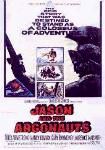 |
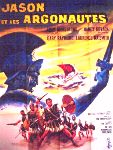 |
 |
| IMAGES |
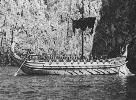 |
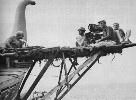 |
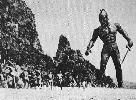 |
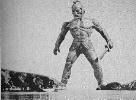 |
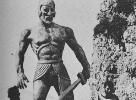 |
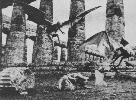 |
 |
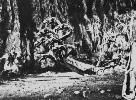 |
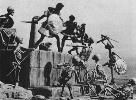 |
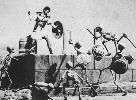 |
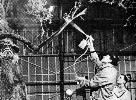 |
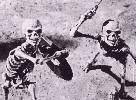 |
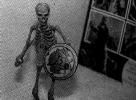 |
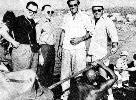 |
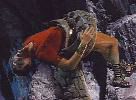 |
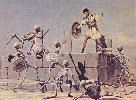 |
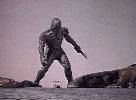 |
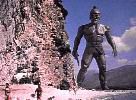 |
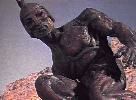 |
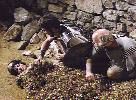 |
| Original Harryhausen Sketches |
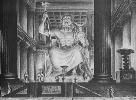 |
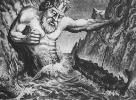 |
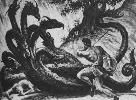 |
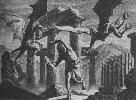 |
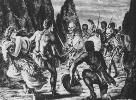 |
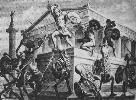 |
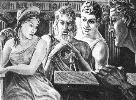 |
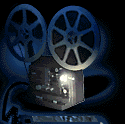
| Home | Features | Short Subjects | Autographs | Equipment |